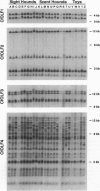Abstract
Four members of the canine olfactory receptor gene family were characterized. The predicted proteins shared 40-64% identity with previously identified olfactory receptors. The four subfamilies identified in Southern hybridization experiments had as few as 2 and as many as 20 members. All four genes were expressed exclusively in olfactory epithelium. Expression of multiple members of the larger subfamilies was detected, suggesting that most if not all of the cross-hybridizing bands in genomic Southern blots represented actively transcribed olfactory receptor genes. Analysis of large DNA fragments using Southern blots of pulsed-field gels indicated that subfamily members were clustered together, and that two of the subfamilies were closely linked in the dog genome. Analysis of the four olfactory receptor gene subfamilies in 26 breeds of dog provided evidence that the number of genes per subfamily was stable in spite of differential selection on the basis of olfactory acuity in scent hounds, sight hounds, and toy breeds.
Full text
PDF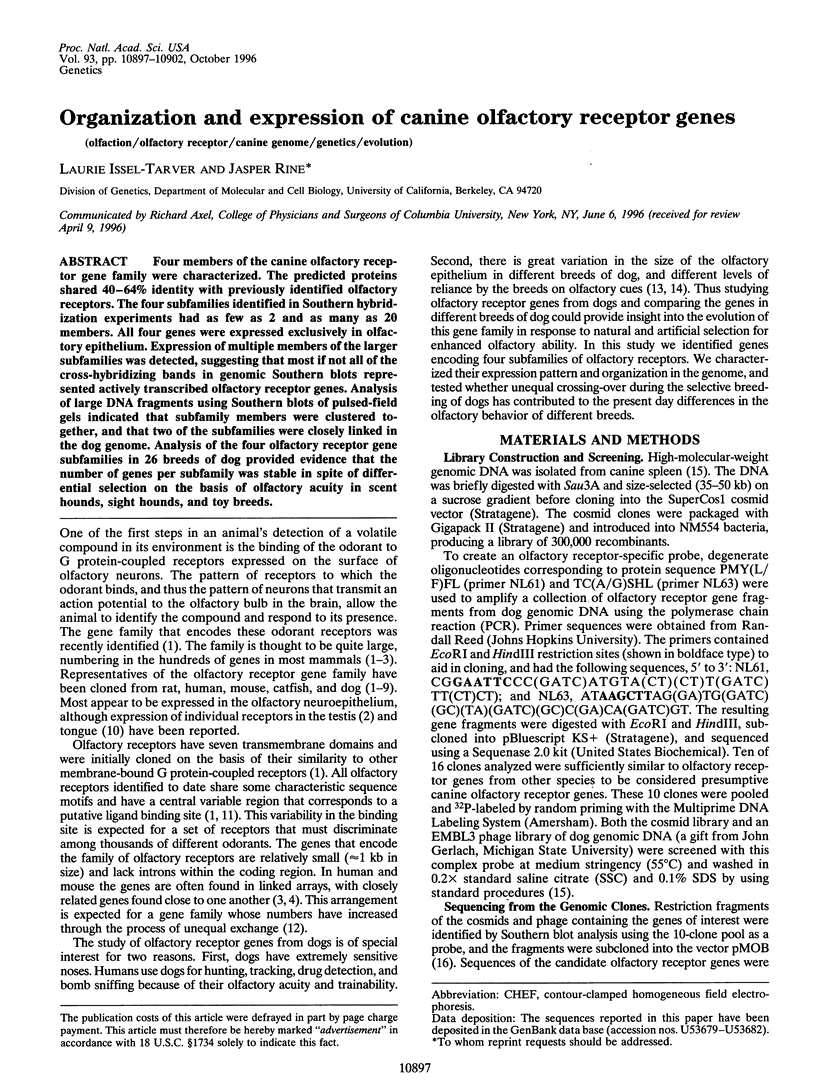
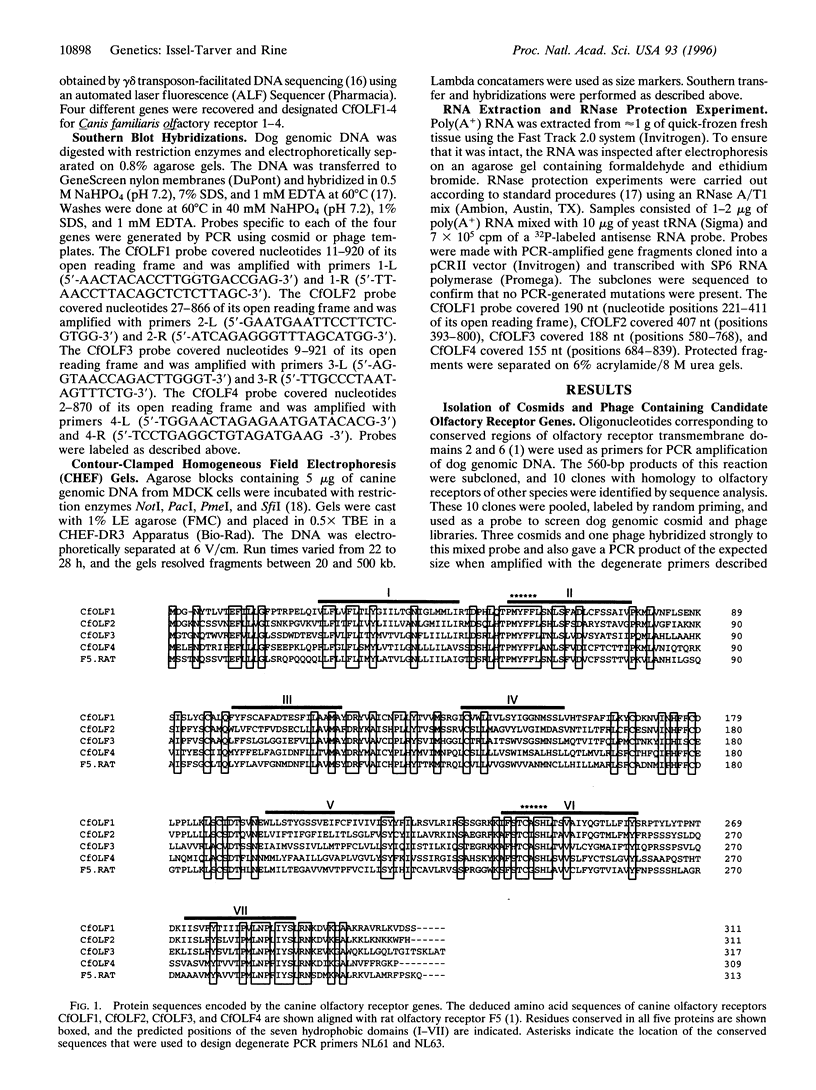
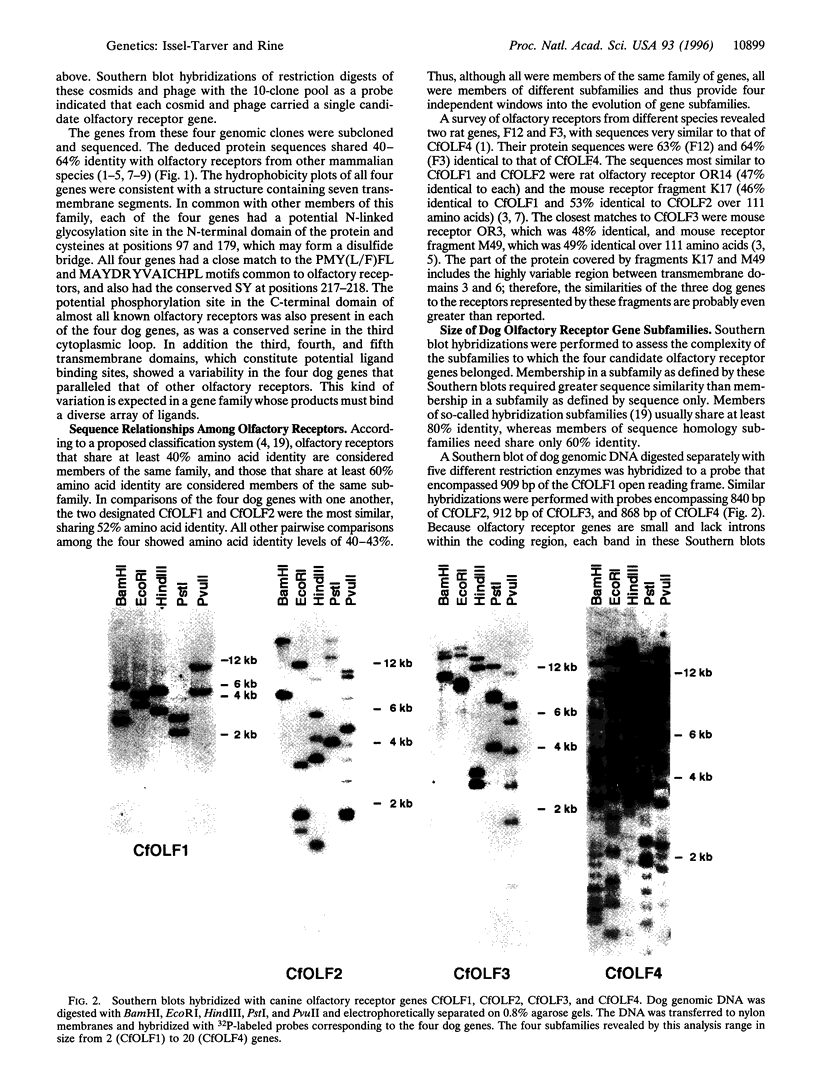
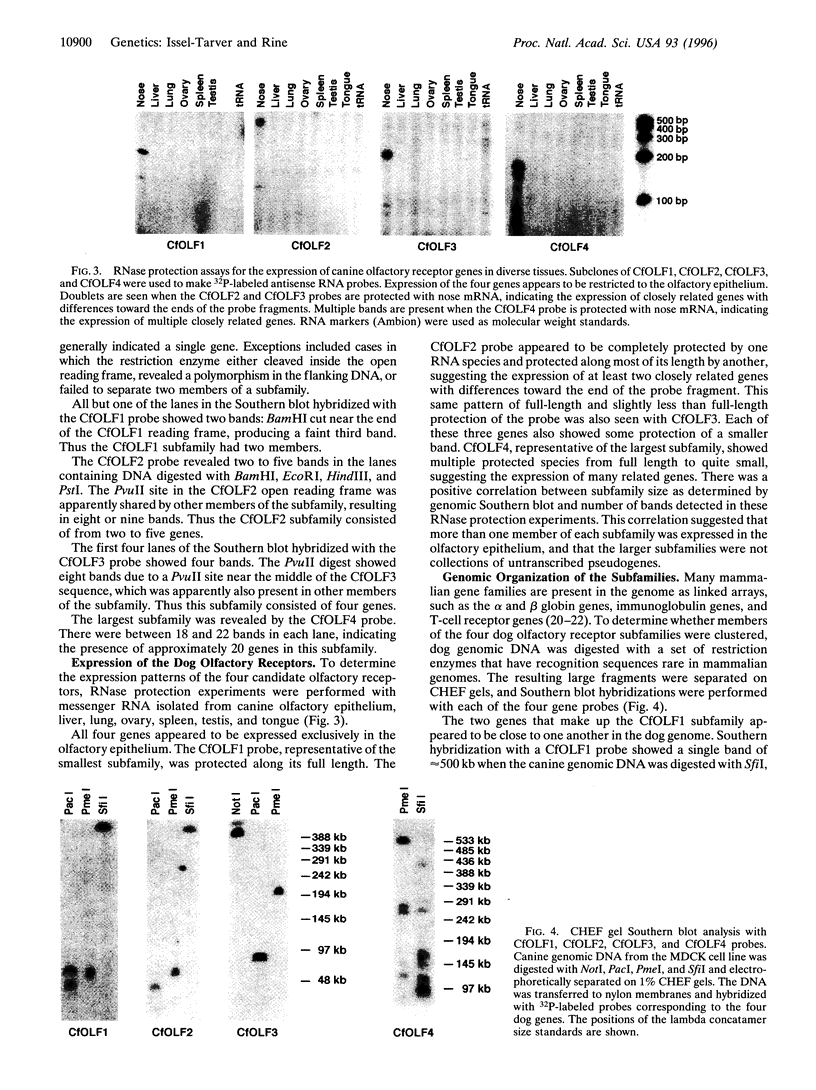
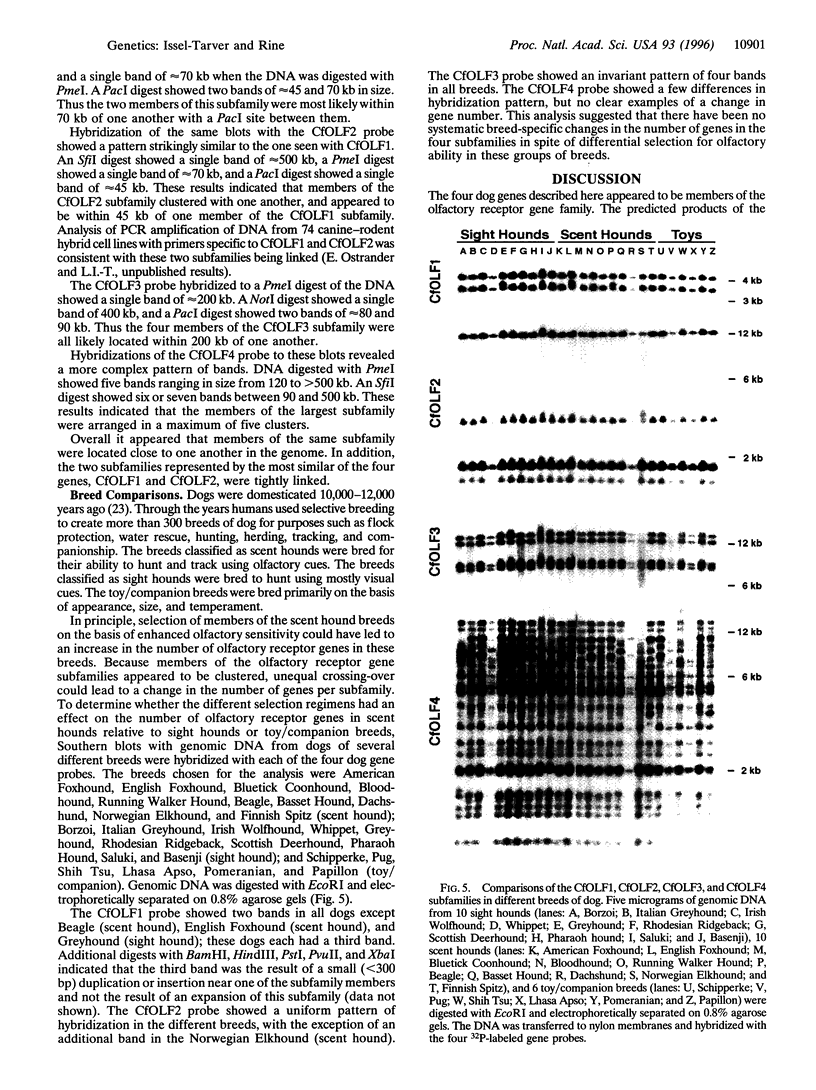
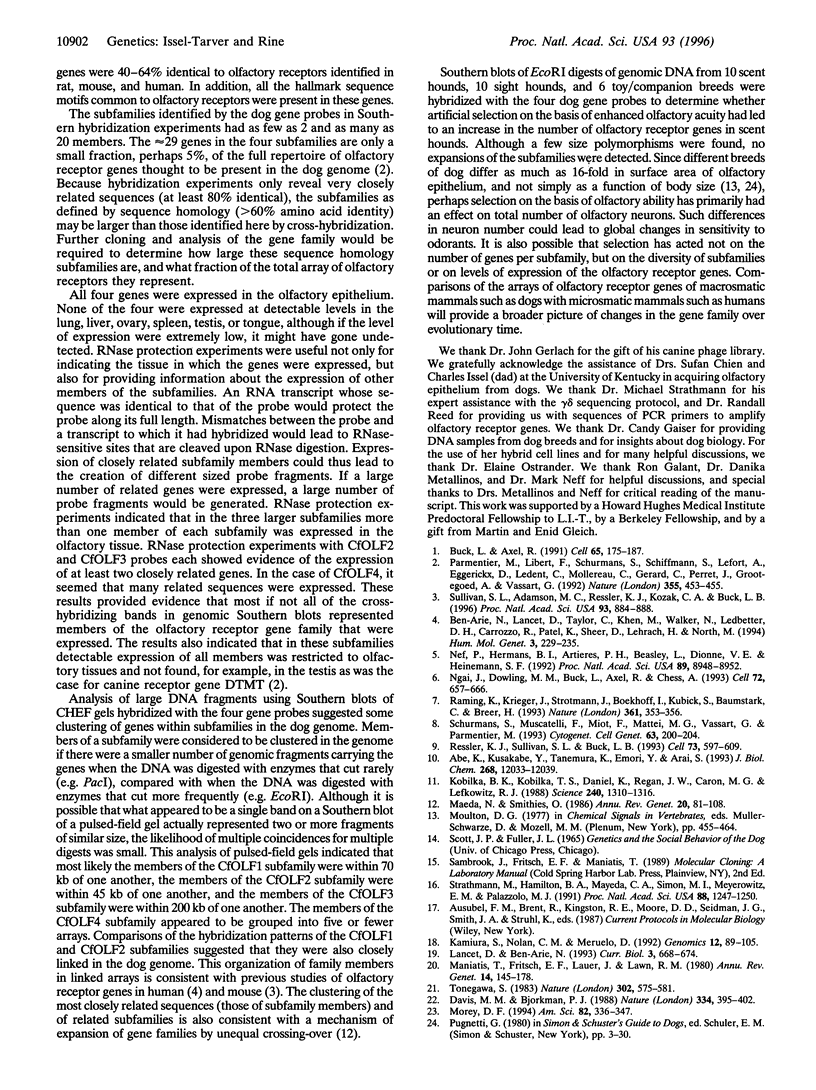
Images in this article
Selected References
These references are in PubMed. This may not be the complete list of references from this article.
- Abe K., Kusakabe Y., Tanemura K., Emori Y., Arai S. Primary structure and cell-type specific expression of a gustatory G protein-coupled receptor related to olfactory receptors. J Biol Chem. 1993 Jun 5;268(16):12033–12039. [PubMed] [Google Scholar]
- Ben-Arie N., Lancet D., Taylor C., Khen M., Walker N., Ledbetter D. H., Carrozzo R., Patel K., Sheer D., Lehrach H. Olfactory receptor gene cluster on human chromosome 17: possible duplication of an ancestral receptor repertoire. Hum Mol Genet. 1994 Feb;3(2):229–235. doi: 10.1093/hmg/3.2.229. [DOI] [PubMed] [Google Scholar]
- Buck L., Axel R. A novel multigene family may encode odorant receptors: a molecular basis for odor recognition. Cell. 1991 Apr 5;65(1):175–187. doi: 10.1016/0092-8674(91)90418-x. [DOI] [PubMed] [Google Scholar]
- Davis M. M., Bjorkman P. J. T-cell antigen receptor genes and T-cell recognition. Nature. 1988 Aug 4;334(6181):395–402. doi: 10.1038/334395a0. [DOI] [PubMed] [Google Scholar]
- Kamiura S., Nolan C. M., Meruelo D. Long-range physical map of the Ly-6 complex: mapping the Ly-6 multigene family by field-inversion and two-dimensional gel electrophoresis. Genomics. 1992 Jan;12(1):89–105. doi: 10.1016/0888-7543(92)90411-k. [DOI] [PubMed] [Google Scholar]
- Kobilka B. K., Kobilka T. S., Daniel K., Regan J. W., Caron M. G., Lefkowitz R. J. Chimeric alpha 2-,beta 2-adrenergic receptors: delineation of domains involved in effector coupling and ligand binding specificity. Science. 1988 Jun 3;240(4857):1310–1316. doi: 10.1126/science.2836950. [DOI] [PubMed] [Google Scholar]
- Lancet D., Ben-Arie N. Olfactory receptors. Curr Biol. 1993 Oct 1;3(10):668–674. doi: 10.1016/0960-9822(93)90064-u. [DOI] [PubMed] [Google Scholar]
- Maeda N., Smithies O. The evolution of multigene families: human haptoglobin genes. Annu Rev Genet. 1986;20:81–108. doi: 10.1146/annurev.ge.20.120186.000501. [DOI] [PubMed] [Google Scholar]
- Maniatis T., Fritsch E. F., Lauer J., Lawn R. M. The molecular genetics of human hemoglobins. Annu Rev Genet. 1980;14:145–178. doi: 10.1146/annurev.ge.14.120180.001045. [DOI] [PubMed] [Google Scholar]
- Nef P., Hermans-Borgmeyer I., Artières-Pin H., Beasley L., Dionne V. E., Heinemann S. F. Spatial pattern of receptor expression in the olfactory epithelium. Proc Natl Acad Sci U S A. 1992 Oct 1;89(19):8948–8952. doi: 10.1073/pnas.89.19.8948. [DOI] [PMC free article] [PubMed] [Google Scholar]
- Ngai J., Dowling M. M., Buck L., Axel R., Chess A. The family of genes encoding odorant receptors in the channel catfish. Cell. 1993 Mar 12;72(5):657–666. doi: 10.1016/0092-8674(93)90395-7. [DOI] [PubMed] [Google Scholar]
- Parmentier M., Libert F., Schurmans S., Schiffmann S., Lefort A., Eggerickx D., Ledent C., Mollereau C., Gérard C., Perret J. Expression of members of the putative olfactory receptor gene family in mammalian germ cells. Nature. 1992 Jan 30;355(6359):453–455. doi: 10.1038/355453a0. [DOI] [PubMed] [Google Scholar]
- Raming K., Krieger J., Strotmann J., Boekhoff I., Kubick S., Baumstark C., Breer H. Cloning and expression of odorant receptors. Nature. 1993 Jan 28;361(6410):353–356. doi: 10.1038/361353a0. [DOI] [PubMed] [Google Scholar]
- Ressler K. J., Sullivan S. L., Buck L. B. A zonal organization of odorant receptor gene expression in the olfactory epithelium. Cell. 1993 May 7;73(3):597–609. doi: 10.1016/0092-8674(93)90145-g. [DOI] [PubMed] [Google Scholar]
- Schurmans S., Muscatelli F., Miot F., Mattei M. G., Vassart G., Parmentier M. The OLFR1 gene encoding the HGMP07E putative olfactory receptor maps to the 17p13-->p12 region of the human genome and reveals an MspI restriction fragment length polymorphism. Cytogenet Cell Genet. 1993;63(3):200–204. doi: 10.1159/000133534. [DOI] [PubMed] [Google Scholar]
- Strathmann M., Hamilton B. A., Mayeda C. A., Simon M. I., Meyerowitz E. M., Palazzolo M. J. Transposon-facilitated DNA sequencing. Proc Natl Acad Sci U S A. 1991 Feb 15;88(4):1247–1250. doi: 10.1073/pnas.88.4.1247. [DOI] [PMC free article] [PubMed] [Google Scholar]
- Sullivan S. L., Adamson M. C., Ressler K. J., Kozak C. A., Buck L. B. The chromosomal distribution of mouse odorant receptor genes. Proc Natl Acad Sci U S A. 1996 Jan 23;93(2):884–888. doi: 10.1073/pnas.93.2.884. [DOI] [PMC free article] [PubMed] [Google Scholar]
- Tonegawa S. Somatic generation of antibody diversity. Nature. 1983 Apr 14;302(5909):575–581. doi: 10.1038/302575a0. [DOI] [PubMed] [Google Scholar]






